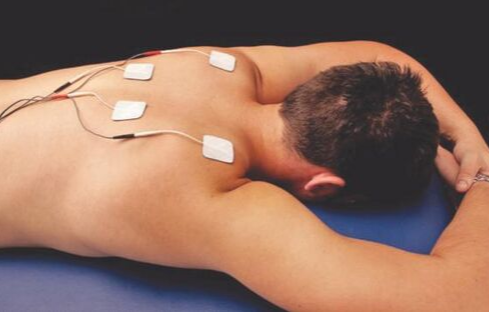ELECTRO THERAPY

WHAT IS ELECTRO THERAPY?
Electrotherapy is a form of medical treatment that involves the use of electrical stimulation to treat various conditions. It is a non-invasive technique that uses electrical energy to stimulate nerves and muscles, which can help to relieve pain, reduce inflammation, and promote healing. There are several different types of electrotherapy, including: 1. Transcutaneous electrical nerve stimulation (TENS): This involves applying small electrical impulses to the skin using electrodes, which can help to relieve pain and promote healing. 2. Neuromuscular electrical stimulation (NMES): This involves applying electrical impulses to specific muscles to help improve muscle strength and function. 3. Interferential therapy: This involves using a high-frequency electrical current to stimulate deep tissues and promote healing. 4. Ultrasound therapy: This involves using high-frequency sound waves to stimulate tissues and promote healing.
HOW A PHYSIOTHERAPIST WILL HELP YOU?
A physiotherapist may use electrotherapy as part of their treatment plan to help patients with various conditions. Before using electrotherapy, the physiotherapist will conduct a thorough assessment of the patient’s condition, medical history, and other factors to determine if electrotherapy is appropriate for the patient.
If electrotherapy is deemed appropriate, the physiotherapist will then select the most appropriate type of electrotherapy and set the parameters for the treatment based on the patient’s individual needs. They will also ensure that the patient is comfortable and safe throughout the treatment.
During the treatment, the physiotherapist will apply the electrodes to the patient’s skin in the appropriate areas and adjust the intensity and frequency of the electrical impulses as needed. They will also monitor the patient’s response to the treatment and make adjustments as necessary. There are several different types of electrotherapy modalities, each with their own specific uses and benefits.
Some of the most common electrotherapy modalities include:
- Transcutaneous electrical nerve stimulation (TENS): TENS is commonly used to manage pain, particularly chronic pain. The electrical impulses delivered through TENS can help to reduce pain signals to the brain and promote the release of endorphins, which are natural painkillers.
- Neuromuscular electrical stimulation (NMES): NMES is often used to help improve muscle strength and function in patients with muscle weakness or atrophy due to injury, surgery, or neurological conditions.
- Interferential therapy (IFT): IFT is a form of electrotherapy that uses a high-frequency current to stimulate deep tissues and promote healing. It can be used to manage pain, reduce inflammation, and improve blood flow.
- Ultrasound therapy: Ultrasound therapy uses high-frequency sound waves to stimulate tissues and promote healing. It is often used to reduce pain and inflammation, improve circulation, and promote tissue repair.
- Electrical muscle stimulation (EMS): EMS uses electrical impulses to contract muscles and improve strength and function. It is commonly used in sports medicine and rehabilitation settings to help athletes recover from injuries and improve their performance.
- Shortwave diathermy: Shortwave diathermy uses high-frequency electromagnetic energy to heat deep tissues and promote healing. It can be used to manage pain, reduce inflammation, and promote tissue repair.
- Microcurrent therapy: Microcurrent therapy uses very low-level electrical impulses to stimulate tissues and promote healing. It can be used to manage pain, reduce inflammation, and promote tissue repair.
The specific modality used and its settings will depend on the patient’s individual needs and condition, and should be determined by a qualified healthcare provider, such as a physiotherapist or physician.
Medical conditions in which electro therapy can be used:
Electrotherapy can be used to treat a variety of medical conditions, including:
- Chronic pain: Electrotherapy modalities such as TENS and IFT can be used to manage chronic pain, including conditions such as back pain, neck pain, and arthritis.
- Musculoskeletal injuries: Electrotherapy modalities such as NMES, EMS, and ultrasound therapy can be used to help improve muscle strength and function and promote tissue healing in patients with musculoskeletal injuries, such as sprains, strains, and fractures.
- Neurological conditions: Electrotherapy can be used to treat neurological conditions such as stroke, spinal cord injuries, and multiple sclerosis by improving muscle strength, reducing muscle spasticity, and promoting neurological recovery.
- Wound healing: Electrotherapy modalities such as shortwave diathermy and microcurrent therapy can be used to promote tissue healing and reduce inflammation in chronic wounds.
- Respiratory conditions: Electrotherapy modalities such as high-frequency chest wall oscillation (HFCWO) can be used to help clear mucus and improve respiratory function in patients with conditions such as cystic fibrosis and chronic obstructive pulmonary disease (COPD).
- Lymphedema: Electrotherapy modalities such as electrical muscle stimulation (EMS) and high-voltage pulsed current (HVPC) can be used to help manage lymphedema, a condition characterized by swelling and fluid buildup in the limbs.
Contact KURE CLINIC today to book your appointment.
